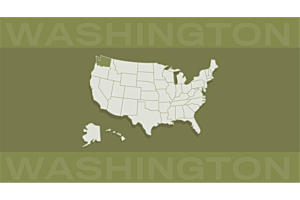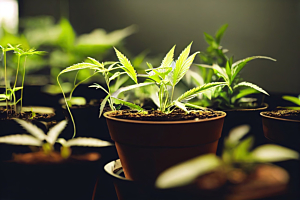Contents
How to grow healthy marijuana seedlings
When should you transplant cannabis seedlings?
Common issues with cannabis seedlings
Grow your seedlings into healthy weed plants
Do you want to transform your cannabis seedling into a healthy crop yielding a bountiful harvest? Start by mastering its needs and learn how to care for your young plant.
The seedling stage is vital to your weed plant’s health and production. It’s imperative to understand the requirements and correctly deal with any issues.
Keep reading to become a pro in caring for your cannabis plant after it germinates. We’ll reveal the optimal temperature, nutrients, pH, and humidity your baby weed sprout needs.
Stick around to make your marijuana garden green and productive.
How to grow healthy marijuana seedlings
It’s essential to understand the stages of a weed plant’s life to master the art of growing healthy and happy cannabis seedlings.
The cultivation process has four main phases:
- Germination
- Seedling stage
- Vegetative stage
- Flowering stage
A marijuana seed germinates by sprouting two cotyledons (tiny leaves) and developing taproots. After this process occurs, it enters the seedling stage.
This phase involves the development of fan leaves with serrated edges. The stems become robust, and more roots form. During this stage, your seedling is fragile and needs proper care to survive.
Here’s a look at the requirements for a healthy and robust marijuana plant:
A healthy weed seedling’s appearance
What does a weed seedling look like? After germination, the young plant sprouts two small, round, and vibrant green leaves. If the cotyledons appear yellow or display brown tips, there may be a problem.
How do weed plants look when they start growing? As the seedling develops, it forms more leaves with a medium green hue. The stem gets taller, and the roots become more expansive. If the crop has a yellow coloration, it might lack nutrients.
Temperature for cannabis seedlings
Young weed plants prefer temperatures ranging from 72–79°F during the day. At night, they thrive in cooler conditions of about 70°F.
If it’s too hot, the seedlings can suffer from heat stress. Some symptoms include stunted growth, brown leaves, or death in extreme conditions.
Cold temperatures may reduce the plants’ metabolism rate and prevent photosynthesis. The seedlings struggle to absorb essential nutrients, water, and oxygen required for growth. If the temperature falls too low, the young seedlings can wither and die.
Indoors, install a reliable air conditioner that can assist in maintaining the right temperature for weed plants. If your area has a hot climate, ensure you switch off the lights during the day to keep the room cool.
Setting up a heating mat can assist in raising the cannabis seedling temperature to the desired level. Another tip is to plant marijuana strains best suited to your area’s climatic conditions. For example, autoflowering weed seeds typically flourish in warmer environments.
Humidity for weed seedlings
Humidity refers to the quantity of water vapor contained in the air. How does it affect marijuana growth? Humidity impacts numerous processes, such as transpiration, photosynthesis, and the absorption of water and nutrients.
The best humidity level for weed seedlings is around 60–70%. These conditions promote optimal root development and water absorption.
If the humidity is too high, it can lead to the wilting or rotting of the foliage. It also increases the risk of diseases and attacks by fungi or pests. Invest in a dehumidifier or a fan to kick the hot air out of your growing garden.
Low cannabis seedling humidity might make the leaves turn yellow, cause the plant to have stunted growth, or wilt and die. Sprinkle water on the soil to moisten it, or install a humidifier to adjust the room conditions.
Lighting schedule for marijuana seedlings
All plants, including cannabis, require light for photosynthesis. This process leads to the formation of energy needed for growth and production. The ideal light for marijuana plants depends on whether you’re growing them indoors or outside.
If it’s the latter, you don’t have much control over how long the sun shines. A controlled environment is preferred during the seedling stage, as it allows you to monitor how much light the weed plants get.
The ideal cannabis seedling light schedule is 18 hours of brightness and 6 hours of darkness.
Use compact fluorescent light (CFL) bulbs when the plants are 10–14 days old. They produce less heat, and the rays aren’t powerful enough to stress the seedlings. After they develop robust leaves, opt for light-emitting diodes (LED) or high-intensity discharge (HID) lights.
It’s also an excellent idea to acquire digital timers to ensure the cannabis seedling light schedule is consistent.
Too much light may cause leaf burn and affect the crop’s health. Leaving the seedlings in the darkness for extended periods can lead to slow growth.
Nutrients for cannabis seedlings
A healthy cannabis seedling requires minerals to thrive and deliver massive buds. Weed plants need major nutrients such as nitrogen (N), potassium (K), and phosphorus (P).
The minor ones include calcium (Ca), copper (Cu), and magnesium (Mg). The best nutrients for cannabis assist plants in developing an extensive root system and encourage healthy growth. Weed can absorb these vital minerals from organic and inorganic fertilizers.
Synthetic nutrients can be in granule form (bags) or liquid (bottles). The packaging displays the quantity of the essential minerals it contains. If you see an NPK label, it means the fertilizer has a specific nitrogen, phosphorus, and potassium ratio.
Organic nutrients are derived from natural sources. They include chicken manure, worm castings, wood ash, seaweed, and compost.
Provide the young plants with minerals sparingly to avoid developing marijuana seedling problems, such as nutrient burn.
Pot size for weed seedlings
Selecting the correct pot size minimizes the risks of over or underwatering. When the growing container is too large, the soil may hold more H2O than the plant can absorb.
Start the seedlings in small containers and transplant them to larger ones after they develop bigger leaves. The ideal pot size for weed saplings is about 2–5 gallons.
Undersized cannabis containers may lead to slow growth as the crops become rootbound due to limited space.
Ensure the pots you use to grow weed plant seedlings have proper drainage. The container should have holes that allow excess water to run off and reduce the risk of root rot.
Consider the strain when selecting the pot size for your marijuana plant. Some cultivars grow taller and require bigger containers for proper root development and growth.
Watering marijuana seedlings
Plants need water for numerous processes, including transpiration, photosynthesis, and nutrient transportation.
Although watering cannabis plants sounds easy, doing it wrong can adversely affect your crop. Consider the environmental conditions, seedling size, and growing medium before embarking on this process.
One of the common mistakes growers make is overwatering their seedlings. How can you avoid this error? Insert your finger one or two inches deep into the soil and check whether it’s wet. If it’s dry, proceed to give your crops a drink.
Sprinkle water around the plant’s stem until the soil is moist but not overly wet. Leave the marijuana seedlings for a few days before giving them another drink.
Another mistake you might make is underwatering your seedlings. Leaving the plant without water for an extended period hinders the occurrence of vital processes. The roots and leaves dry out, and if you don’t act fast, it might die.
The rule of thumb is to ensure the soil is consistently moist. Don’t let it dry completely.
Ideal pH levels for cannabis seedlings
The acidity or alkalinity of your growing medium also affects the plant’s health. Marijuana thrives in pH levels ranging from 6.0–7.0.
How do pH levels affect weed plants? As mentioned, marijuana plant seedlings require minerals and nutrients to carry out various processes.
If the growing medium is too acidic or alkaline, it hinders the absorption of these minerals. We refer to this condition as a nutrient lockout.
The soil may have all the necessary macro and micronutrients, but the seedlings won’t absorb or use them. Invest in a pH meter to determine if the medium is within the required range (slightly acidic).
A low pH (1–5) shows overly acidic soil, which can cause leaf discoloration. The plants struggle to absorb nutrients at high levels, which indicates alkalinity, resulting in slow growth.
Adding pine needles, compost tea, or manure can help regulate the pH levels. Some growers use lime, which is alkaline, to reduce soil acidity.
When should you transplant cannabis seedlings?
Learning when to transplant your cannabis seedling is crucial. Weed seeds usually sprout in a small container. Transferring the young plants to a larger pot gives the roots enough space to spread out fully.
Containers that are too small can result in rootbound, choke your seedling, reduce growth rate, or cause death. Use a one-gallon pot during germination to minimize water wastage and encourage the seed to sprout.
Here are a few things to check to know when to transplant the seedlings:
- The number of leaves: When the young plant develops four or more leaves (depending on the strain), it’s ready for a larger pot.
- Extensive root system: If the roots have fully formed and start protruding from the container’s drainage holes, it’s time for an immediate transplant. If you notice leaf discoloration, the plant may be rootbound, requiring a larger pot to keep growing.
- Size: Once the seedling reaches more than 12 inches, it needs a larger-sized pot (more than three gallons). Transplant it if the leaves cover the entire container.
Once you’re ready to transplant your healthy marijuana seedlings, follow these simple steps:
- Water the plant slightly to moisten the soil.
- Gently uproot the seedling, taking care not to damage the roots.
- Carefully plant the seedling in the new pot and water it.
Common issues with cannabis seedlings
Growing healthy marijuana plants requires understanding the various weed seedling problems and how to fix them.
Let’s discuss a few cannabis seedling issues you might encounter while growing weed and ways to deal with them.
Slow or stunted growth
Have you discovered that some of your seeds didn’t sprout? You may also notice that your young marijuana plants are growing slowly. What could be the issue?
One of the main factors that contribute to stunted growth is watering problems. Seedlings require adequate H2O to thrive and be healthy.
If your plant wilts and the leaves turn brown, it might indicate underwatering. If the seedling becomes too dehydrated, the root system dries, and the growth rate reduces.
Incorrect pot size typically causes your seedling to grow slowly. If the cannabis container is too large, it may lead to overwatering. When the soil is too wet, the plant lacks oxygen, and the roots drown, which may lead to death.
A small pot may also result in stunted growth. A lack of space halts root development, causing the plant to mature slowly. Prevent sluggish maturity by transplanting the seedlings to a larger pot with adequate room for growth.
Damping off
Damping off is a common fungal disease that affects young cannabis plants. The fungi that cause this condition include Fusarium, Pythium, and Botrytis.
High humidity and overwatering also encourage damping off. These conditions contribute to the wetness that fungi need to thrive.
What are the signs of damping off? The stem forms spots and appears weak. It then goes limp, causing the seedling to fall and die.
If one or more plants die from damping off, remove them to prevent fungi from spreading to other seedlings. Take an extra step and sterilize your growing room using chemicals like hydrogen peroxide.
Prevent seedlings from damping off by maintaining ideal relative humidity and avoid overwatering the plants.
Nutrient problems
Cannabis plants require nutrients to thrive. Ensure you only provide enough, as too much or little may cause problems.
One of the most common cannabis seedling problems is nutrient deficiency. This condition means that the growing medium lacks or doesn’t have the correct minerals. If the seedlings are in a small pot, they may absorb all the nutrients and end up without enough.
What does a weed seedling look like when it lacks essential nutrients? A nitrogen deficiency causes the oldest leaves to turn yellow and then brown. After a while, they become soft and crispy and eventually fall off.
Nutrient toxicity occurs when the soil has excess minerals that the plant can’t absorb. It causes the leaves to turn dark green and have burnt tips. Some possible causes for nutrient toxicity include:
- Excess nutrients: Applying too much fertilizer at once can burn the crops overnight. Provide the minerals gradually to avoid shocking the plants in the seedling stage of cannabis.
- Giving nutrients when the seedling is too young: Baby weed sprouts don’t require excess minerals. The fertilizer can burn them since they’re still fragile.
- Planting in hot soil: If your growing medium has an overload of nutrients, it may cause adverse effects on your seedlings. Use pH-balanced water to correct this issue and resist adding fertilizer to the soil.
Pests and bugs
Young weed plants are prone to pest attacks. Keep the bugs away by remaining vigilant and checking your seedlings often. It's also essential to ensure the environment is clean and sterilized.
Common cannabis pests include:
- Spider mites: These tiny pests hide underneath the leaves and can be challenging to eliminate. Use rubbing alcohol or pesticides to kill these bugs.
- Fungus gnats: These tiny fly-like insects live on the soil and damage the seedlings' roots. Eliminate them by applying diatomaceous earth to the growing medium, watering less frequently, or using yellow sticky traps.
- Leaf miners: These bugs live inside the leaves and leave irregular discolored trails as they feed on the tissue. Remove the affected blades, and use neem oil or BT spray to control them.
- Aphids: These insects are oval-shaped and can be brown, black, or red. They feed on the plant’s sap juice in leaves or stems. Remove affected plants or spray chemicals to get rid of these pests.
Stretchy seedlings
Placing a light source too far causes the plants to stretch as they try to reach it. Prevent the seedlings from having long and feeble stems by installing CFL or LED bulbs slightly above the young weed crops.
A lack of nitrogen in the soil could also contribute to stretchy seedlings. Too much heat may make the stems grow faster than the leaves, leading to an elongated plant.
Another way of avoiding plant stretching is by providing enough space. Ensure sufficient light and air circulation to develop healthy cannabis seedlings.
Grow your seedlings into healthy weed plants
You’ve now learned how to care for, transplant, and deal with various issues that might affect your weed seedlings. What’s next? Get top-quality cannabis seeds for sale online from our store and start your marijuana growing journey.











